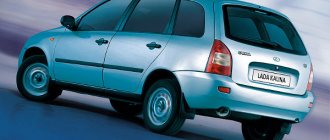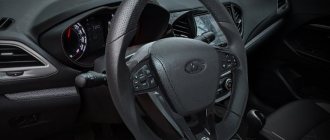Once upon a time, a Nobel laureate and Miss Universe met. “Let’s have sex and I’ll give birth to your children,” she suggested. - They will inherit beauty from me, and intelligence from you, and will be the best on the planet! “Perhaps they will take my beauty and your intelligence,” the laureate retorted.
Lada Vesta is certainly a beauty, but... What did car enthusiasts expect from the acquisition of AvtoVAZ by the Renault Nissan alliance? It is likely that the new Lada will have the quality and technology of foreign cars, but the “beautiful” Russian prices will remain. It definitely didn’t work out with the price, but what about the smart part, the technology? And what is more in Vesta, a foreign car or a Russian car? Perhaps it all depends on whether the glass of water seems half empty or half full, but let's figure it out...
Vesta's place among non-locals
For more than a year now, Vestas have been rolling off the assembly line and delighting happy car enthusiasts. During this time, the car showed itself at a high level. Previous Lada models are definitely inferior in many respects - within the Vesta brand there is no competition. But as for our foreign brothers, it makes sense to compete, which is what we will do today.
In this article we will separately compare such parameters as “appearance”, “dynamic characteristics”, “equipping options and prices”. The choice of competitors is quite large, but we will limit ourselves to five models that are most suitable for a fair and interesting fight:
- Volkswagen Polo Sedan
- Hyundai Solaris
- Renault Logan
- Skoda Rapid
- Kia Rio
All of the above cars are budget sedans with comparable technical characteristics and prices to the Lada Vesta. Each model has its own highlights and its own mistakes, which are more noticeable compared to other cars. But, since we are talking mainly about Lada Vesta, this new product of the domestic automobile industry will act as a background. So, let's start the review by examining the design of each car.
Nissan Almera - a budget car exclusively for Russia
Vesta was made almost exclusively for Russia, as well as for some CIS countries. In the same way, a few years ago Almera was made from the Japanese concern Nissan. The company developed a budget sedan in a fairly large size, equipped it with some proprietary appearance features similar to the then Teana generation, and also supplied the simplest and most durable technical components. As a result, Almera can surprise the buyer with the following features:
- excellent reliability inherent in a Japanese corporation, amazing capabilities of operation without special repairs and maintenance for a long time;
- very comfortable interior space, which largely follows the classic Japanese tradition of creating a high-quality passenger car interior;
- it must be admitted that Nissan Almera offers a more thoughtful, albeit simple, technology, which suppresses almost all the advantages of the new Lada;
- in terms of travel comfort, the Japanese is approximately on the same level as Vesta, but offers more efficiently used space inside;
- For its 499,000 rubles in the basic version, this car offers practically nothing active, but it is worth remembering that the car turned out to be cheaper than Vesta.
This is in the same class as the Russian Vesta, and the Japanese manage not to raise the cost of their equipment. It is also surprising that not many Russian buyers were favorable to this model. Today, the popularity of Almera is on the verge of profitability of sales, and even a frankly low competitive price does not help the company actively sell its offer.
Car appearance
As they say, people are greeted by their clothes, so let’s start with that. Agree, it’s quite a pleasant feeling when you leave your house in the morning and clearly see that your car has a special look among other unremarkable neighbors’ cars. Of course, everything here depends on your individual idea of modernity and uniqueness of design, so first of all, your personal opinion about the appearance of the car is important. Below we will transfer the analogy with neighbor's cars, only we will already know which of the neighbors drives what. So, let's break it down:
Instructions: Lada Vesta door handle - repair
On a Lada Vesta car, the door handle is considered a consumable item. This also applies to other VAZ cars where Euro handles are installed. The door handle of Lada Vesta cars is a weak element; they often break and peel off. The outer part of the front door is especially susceptible to this - due to frequent opening by the driver, it suffers more than others. He pulled sharply in the cold, not careful handling - the door handle does not forgive this. Sometimes it does not return to its original position and jams. If suddenly your outer or inner handle breaks, you can deal with the problem by contacting the warranty service of a Vesta dealer yourself. Repairing and replacing consumables is not a tricky matter; to do this, it is enough to know the structure of the door handle on Vesta. Read the article and we will answer your questions in detail: remove, replace, buy the original according to the article number!
Specifications. Dimensions
Technical characteristics are a rather loose concept. For the review, we chose the dimensional data of the cars and the dynamic capabilities of the engines, since this is what interests car owners most. So, let's start with the size of the cars, their ground clearance and trunk volume:
| Automobile | LxWxH | Clearance | Wheelbase | Trunk volume |
| Lada Vesta | 4410x1764x1497 | 178 | 2635 | 480 |
| Volkswagen Polo | 4390x1699x1467 | 163 | 2553 | 460 |
| Hyundai Solaris | 4405x1729x1469 | 160 | 2600 | 480 |
| Renault Logan | 4346x1733x1517 | 155 | 2634 | 510 Thanks for subscribing! |
| Skoda Rapid | 4483x1706x1461 | 170 | 2602 | 550 |
| Kia Rio | 4370x1700x1470 | 160 | 2570 | 500 |
And the Lada Vesta has the most impressive dimensions, losing only in height to its French competitor. The ground clearance is especially impressive - almost 18 centimeters versus 15-17 for other models. The wheelbase is also the largest, which gives the Lada a great advantage in the form of excellent stability. As for the volume of the luggage compartment, the Russian car firmly holds the middle position, and the Skoda Rapid wins everyone by a wide margin - the luggage compartment volume is 550 liters. Moreover, if the rear seats are folded down, the useful volume will increase to 1490 liters. As a result, it turns out that the most stable and passable car among those under consideration is the Lada Vesta, which is undoubtedly an advantage and puts it in first place in terms of dimensional characteristics.
Specifications. Dynamics
Now let’s find out which cars have the most powerful and large-capacity engines by studying the minimum and maximum configurations. The Lada Vesta is equipped with two engine options - a 1.6 liter with a power of 106 hp. and 1.8-liter with 122 hp. The first option comes as standard and, combined with a manual gearbox, accelerates the car to 100 km/h in 11.2 seconds. The second, more powerful engine has a phase adjustment mechanism, which helps very well in accelerating to 100 km/h, which is 10.2 seconds. The maximum speed with the 1.6 engine is 175 km/h, and with the 1.8 engine – 188 km/h. Let's compare other competitors with Lada.
| Automobile | Minimum equipment | Maximum configuration | ||||||
| Volume | Power | Overclocking | Max. soon | Volume | Power | Overclocking | Max. soon | |
| Lada Vesta | 1,6 | 106 | 11,2 | 175 | 1,8 | 122 | 10,2 | 188 |
| Volkswagen Polo | 1,6 | 90 | 11,2 | 178 | 1,4 | 125 | 9,0 | 198 |
| Hyundai Solaris | 1,4 | 100 | 12,2 | 185 | 1,6 | 123 | 10,3 | 193 |
| Renault Logan | 1,6 | 82 | 11,9 | 172 | 1,6 | 113 | 10,7 | 177 |
| Skoda Rapid | 1,6 | 90 | 11,4 | 185 | 1,4 | 125 | 9,0 | 208 |
| Kia Rio | 1,4 | 107 | 11,5 | 190 | 1,6 | 123 | 10,3 | 190 |
In its minimum configuration, Lada shares first place with Volkswagen in terms of acceleration to 100 km/h and beats only the Frenchman in terms of maximum speed. This puts Vesta in second place among the minimum configurations. In the maximum configuration – 4th position according to all the same parameters. Skoda is far ahead with its 9 seconds and 208 kilometers per hour, and Polo is close behind it, since it is equipped with the same technologically advanced 1.4 engines. But the maximum configuration is not an indicator, since prices can vary greatly, so we unanimously assign Vesta second place in terms of dynamic characteristics.
Ravon Gentra - if looks don't matter
In last place we will put a competitor who cannot but be remembered in this context. The Uzbek brand Ravon offers the Gentra car at a very low price - this is the lowest in its class. With all this, Rayvon Gentra belongs to the pure C-class and is one of the most optimal acquisitions for lovers of deep-rooted classics. Among the important features, the following features of the machine should be noted:
- quite presentable appearance, but obviously outdated design that cannot compete with modern developments, the same Lada Vesta;
- classic technical lines of the car, which adds advantages to the purchase; the Uzbeks did not update the technical part of the car, allowing buyers to obtain reliability;
- good equipment, albeit without the most amazing features, but with a very comfortable ride, taking into account all the features of the car’s origin;
- a spacious interior, well organized, because the predecessor of the car was the Chevy Lacetti, which has proven itself in our world for its practicality;
- the cost of only 439,000 rubles in the basic version is a real gift for lovers of the invincible classics, but the quality corresponds to the price threshold.
When buying a Ravon Gentra car, remember its origin. Most likely, you will find the optimal features of the transport for yourself only if you find the most suitable package for your case. Otherwise, you will initially not be too happy with the purchase and will find a lot of not very interesting features in the machine, which turned out to be the cheapest representative of our review today. We invite you to watch a comparison of Vesta with its main competitors in the video:
Options and prices
So we have crept up to the most interesting thing, because the price should determine the feasibility of all the above-mentioned delights. So, let’s arrange all the models in ascending order by price (basic configuration):
- Renault Logan is the cheapest among all and its cost is 479,000 rubles, which justifies all the shortcomings of this car brand.
- The official Lada website states the minimum price for the Lada Vesta is 515,900 , which immediately sets it apart from its competitors.
- Hyundai Solaris, Skoda Rapid, and Volkswagen Pol o share third place with each other, having a price tag of 599,000 rubles.
- And the Kia Rio with a price of 639,900 rubles loses to everyone in price.
Summing up, we can safely say that the domestic novelty took the top place of the honorary podium of the winners of this review, because for the cost of just over half a million, you get an excellent car with a good engine and an unusual bright design. We can be proud of this, because the domestic manufacturer has finally reached such a level that it has surpassed its European and eastern competitors in many respects. Of course, we are still far from absolute victory, but we are on the right path!
Hyundai Solaris - a little smaller, but in the same class
Of course, we can already hear the indignation of fans of the domestic automobile industry, because comparing Vesta and Solaris is somehow not very convenient. The car from the Korean brand is only slightly smaller than the Russian design, but it offers a lot of wonderful advantages that domestic transport can only dream of. Solaris turned out to be one of the most interesting proposals for Russians and this happened for many reasons:
- the car has perfectly updated its appearance and became completely modern only a few months ago, the car fits perfectly into the general flow on the road;
- technically the car is almost perfect, two engines and perfectly modified gearboxes are combined in the engine compartment and are well suited for Russia;
- the power of the power units is greater than that of the Russian, and in the cabin you can see better assembly, softer plastic and thoughtful interior space;
- driving a Hyundai is a little more comfortable; thoughtful and fully modified controls, braking and other functions improve the quality of the trip;
- at a cost of 569,000 rubles for the basic version, the car can easily compete with the more upscale Vesta with all its shortcomings.
It is clear that the Korean company has been developing the Hyundai Solaris for many years, starting with the very first Accent of 1998. The Russian company started everything from scratch and simply could not create the ideal car, despite cooperation with Nissan and Renault. Therefore, we may well turn a blind eye to some shortcomings, but in a comparative selection of cars, many will prefer Solaris.
About behavior on the road
Vesta SW Cross and Vesta SW Cross are cars that are identical in architecture, but different in behavior. The city station wagon is more comfortable and softer on the road. It passes joints more accurately and does not react to minor unevenness in the road surface. Suspension failures only occur in large potholes when the driver is clearly relaxed and inattentively driving through broken sections of the road. The Vesta SW station wagon does not have a sporty character, but is responsive to drive, just like the platform sedan.
The off-road version is more rigid and collected. Being behind the wheel of an all-terrain station wagon, taking turns at high speed, is much more fun and interesting. However, more distinct impacts spoil the impression of the trip. This is due to suspension settings, higher ground clearance and the presence of low-profile 17-inch tires.
Another characteristic difference is the less natural force on the steering wheel, although the automaker assures that it has not made changes to the settings of the electric power steering or the parameters of the SW Cross rack.
As a result, Vesta in a station wagon body with 178 mm ground clearance is more collected and comfortable on public roads in usual operating modes. Its bright off-road version pleases only with sharper handling and perky character at speeds of 80-100 km/h.
Difference in model transmissions
This similarity may seem strange, but there is practically no difference in the gearboxes. Both models are equipped with a 5-speed manual transmission and a robot. The whole difference is in the production. At Vesta, the mechanics are assembled by AvtoVAZ, and the robot is manufactured in France. Unlike X-ray, the gearboxes of which are always French-assembled.
There are no complaints about the mechanics. The robot sometimes switches gears for a long time, which is why there are jerks. But the gears do not slip out, the transmission is quite quiet and precise. The absence of a classic automatic machine is explained in order to reduce costs.
AFTERWORD
The Russian car enthusiast, and those who had not yet managed to get a car, had a dream that someday it would be possible to drive along a smooth autobahn in Russia or abroad, driving a domestic car, with a sense of pride in their choice. Cut through city traffic, overtaking foreign cars with a feeling of superiority, or “certainly no worse.”
For decades, he bought unsightly, but somehow “native” semi-finished products from the Volzhsky Automobile Plant, supporting the manufacturer. I spent hours and days in the garage, bringing this designer to fruition, troubleshooting and tuning, and when driving out onto the road, I looked with envy at my neighbors downstream. But he understood the price, he understood that even a Moscow janitor could save up for such a Lada, even if it was two years old. And still I waited...
And already somewhere in Russia there are world-class roads, and it would seem that places are coming true, here it is - that same Lada, beautiful, comfortable, but you can’t get rid of the sown seed of doubt... How it was sown in Russia’s victory in the winter Sochi The 2014 Olympics, who did not have time to learn Russian, Viktor An and, no less Russian, Vic Wild, but brought 5 gold medals between them.
One can only speculate how much Vesta would cost if she invested part of the Olympic money in a Russian engineer. At the current rate, it would be bought all over the world, snapped up like Kolkata Kathi rolls in India, Cornish meat pie in the UK or Nachos in Mexico and America.
green Lada Vesta
Time will tell how the buyer will react to this type of business, when they sell their technologies, leaving only a minimum of domestic developments to take advantage of the brand loyalty of the Russian people. Will he pay for an already unrealistic, taken away dream, depriving himself of the opportunity to buy a better car, albeit 10-15% more expensive?
And yet, no matter how many innovations foreign companies introduce, no matter how many shares they own, most likely the Russian spirit will never leave AvtoVAZ, because it is difficult to imagine that at the Nissan plant in Oppama, Japan or Renault - George Besse Douai in France was stolen parts worth 20 million rubles.
With this article, the editors of ATD bring their readers to the main question. What if it was a Daewoo Vesta, Fiat Vesta or Dongfeng Vesta? How significant is the “domestic plus” that Lada invests in its new cars for you?
What's the result?
If you count the number of advantages for each characteristic, then X-ray will win with a slight advantage. But according to a survey of car enthusiasts, the Audience Award goes to Vesta. Because The brand and manufacturer are the same, the build quality of the models is the same, the main difference can be identified - the price of the car.
What does it mean? The choice depends on the preferences and purposes of purchasing a car. XRAY beats its rival, but if you judge individually based on your personal needs and requirements for the car, it may turn out that the urban Vesta is more suitable for you. Therefore, we cannot safely say that Vesta or Xray is better.
If you are young, want to drive around the city, and have a limited budget, choose a sedan. If you are a family member, comfort is important to you, there is a need to travel outside the city, for example to the country, perhaps you want to choose a more powerful engine and have the funds for it, you should take a closer look at the X-ray. In any case, the answer of Vesta or Xray is different for everyone.
How to remove interior door handles on Lada Vesta?
Internal handles often bother drivers with squeaking and unpleasant squeaking noises while driving. This problem can be solved by using a gasket inside the Madeleine part or automotive sealant. You must act in the following order:
- Remove the plastic cover. To do this, you need to carefully pry it over the edge with a flat object and remove it. It is better to use special plastic spatulas that will not damage the decorative coating of the door. This interior element does not have any fasteners in the form of screws or bolts, so it is very easy to remove. The main thing is to act carefully so that the thin plastic does not break.
- After the handle is dismantled, you need to carefully glue the joints with insulating material. To do this, you can use madeline, a special anti-creaking noise-insulating tape that is sold in car dealerships, or fabric electrical tape. It is necessary to glue along the entire perimeter, excluding the clamps, so that the part can hold on. Some drivers use sealant instead of insulating material, but after this treatment it will be difficult to dismantle it again if necessary, and it may need to be completely replaced.
- Reinstall the handle in the reverse order. After gluing it will snap tighter, and you need to tighten it well and press it. We check that everything is done correctly by closing and opening the doors several times.
Interior
Comparing the interior style is completely pointless. As much as the Lada Vesta is bright and attractive inside, the Largus is boring and simple.
Vesta confirms its status as a modern car. The transitions and lines in the dashboard are made in the best traditions, high-quality finishing materials, a comfortable steering wheel, moderately dense and well-profiled seats, a spacious back row, an armrest, well-chosen colors, impressive wells in the dashboard, poisonous lighting, etc.
The interior of the Lada Vesta is original and attractive - there is nothing to reproach it with.
In contrast to Vesta, the station wagon simply has nothing to demonstrate. The dull design of the interior, with its straight lines, surprisingly unnatural metal-look inserts on the budget black plastic of the dashboard and steering wheel, tasteless nozzles for air deflectors, simple instrument dials - the same old Logan, but in a new body. However, the ergonomics are not bad, although some of the controls are blocked by the gearshift lever, and I would like the lateral support of the seats to be more developed. And the orange backlight breaks up the monotony a little.
This is not to say that the interior of the Lada Largus is bad. He's just expressionless.
In general, the Largus interior is quite comfortable, but extremely boring, and after Vesta, being surrounded by such “luxury” is simply unbearable.
Design
The appearance of the domestic station wagon can be called classic relative to all modern models produced by AvtoVAZ. At the front there is a recognizable “X-face”, which the manufacturer creates using inserts between the headlights and the radiator grille. There are also stampings on the sides, wings and doors, which are typical for all modern AvtoVAZ models. The roof of the station wagon has received a serious slope towards the luggage compartment, thanks to which the car looks quite modern and does not create the impression of bulkiness. At the rear, you can note a fairly compact tailgate, on which the manufacturer installed a neat spoiler.
The interior design does not have any frills or original solutions, but at the same time, it looks quite ergonomic. Thanks to the manufacturer’s decision to extend the center console somewhat deeper into the cabin, the driver and front passenger will be able to configure the multimedia system and control the air conditioning unit without any difficulty.
The interior seats are moderately hard and equipped with additional lateral support. The station wagon's interior is quite spacious; three passengers can easily fit in the back.
Removing the front door trim of Lada Vesta
The front cards are the most difficult to remove. They are attached to a larger number of fasteners, and there are more regulators. It is necessary to take into account the adjustment of the mirrors so as not to uproot any electrical wiring clips
Also, care should be taken when dismantling the power window unit - it is this unit that is most often damaged by inept actions with a screwdriver. Caution and lack of haste will be the key to getting the job done right.
The order of actions is as follows:
- Using a plastic spatula prepared in advance, unclip the plastic triangle lock in the area of the rear view mirror control unit. Just pry this element off at the top.
- Disconnect the electrical control connector to prevent it from being torn off when removing the card.
- At the bottom of the card, use the same spatula to remove the lampshade. Disconnect it from the connector and set it aside. Also unscrew the three card fastening screws located at the bottom of this element in the area of the lampshade.
- At the top of the end part (in the plane where the door lock is installed), carefully remove the round plug. Underneath there is another fastening screw that needs to be unscrewed.
- Inside the door closing handle there is another screw for securing the card, which also needs to be carefully unscrewed with a Phillips screwdriver.
- Next is the most difficult part - using a plastic spatula, carefully pry off the window regulator unit so as not to damage its delicate body. Remove the unit from its installation location and disconnect it from the connector.
- There is another fastening screw under the power window control unit that needs to be unscrewed.
- At the bottom of the casing, place a plastic spatula in any corner of the card and gradually pull the plastic towards itself. The clips will begin to come out of their installation locations, and the card will gradually be dismantled.
Once all the clips are removed, you will be able to completely remove the card and get to the metal part of the door. This is a simple procedure that you can do yourself without experience.
But you should pay special attention to accuracy when working with the power window unit. It is at this stage that most inept performers incur additional costs for themselves.
The case cannot be pryed off with a screwdriver, as it will be damaged and will look very ugly.
Main advantages
First of all, I would like to talk about the strengths of the car. Many drivers who bought Vesta highlight the following advantages:
- Decent visibility. All directions are visible without problems, and the side mirrors are of impressive size.
- Spacious and comfortable interior. Three adults can fit in the back;
- Responsive controls. The car, according to drivers and experts, handles excellently.
- High ground clearance – 178 mm. This is an extremely important characteristic for operating a car in the Russian Federation.
- I also liked the design of the new sedan.
As experts note, the first impression largely depends on the configuration. "Lada Vesta" in the base and luxury are completely two different things. But we'll talk about this a little later.
Cost of spare parts
We recently calculated how much it would cost us to repair a car body. The roof rack broke and a pipe fell from it onto the hood. The result was deformation of the hood and front left fender. We based ourselves on the prices of the official dealer for original spare parts.
- The cost of the hood is 13,200 rubles, plus painting and work, a total of 14,000 rubles.
- Front bumper 4800 rubles, with painting – 9000 rubles.
- Front left optics – RUB 14,570.
- Front left fender – 5800 rubles, with painting – 8000 rubles.
- Left front shock absorber – 4200 rub.
- Lever – 5400 rub.
Lada Vesta is cheaper than foreign cars, but it is more expensive than Kalina-2 and Granta. Stamping of body panels is more difficult, so the car is positioned as more expensive in this segment.
Rate the article!
Removing the rear door card on Lada Vesta
In the rear of the car, everything is a little simpler, since manual windows are most often installed here, and there is also no mirror control unit. Up to and total number of fastenings is significantly less. This allows you to spend half as much time on doing the same work. However, you will have to be careful, otherwise you may damage one of the elements and incur additional costs. It is best to also use a plastic interior disassembly kit to avoid scratching or damaging anything.
The instructions will be somewhat shorter than for the front door:
- First you need to remove the window handle or button if you have an electric control option. To do this, use a plastic spatula to pry up the retaining ring and then pull it out with your hands. The rest of the device can be easily removed by hand.
- The door handle trim is also secured with latches. It is enough to snap them off using the same spatula and then remove them with your hands.
- Here you will need a socket wrench of 10, since two mounting bolts are waiting for you under the handle lining. Unscrew them first so as not to violate the card removal technology.
- At the bottom of the card there is a hole with a fastening screw for a Torx 20 - asterisk. This fastener is easy to unscrew; you just need to choose the right tool.
- Next, you just have to snap off the clips one by one, starting from the bottom. It's very simple and don't be afraid to break them, this is a normal process. Then you need to buy and replace them with original fasteners.
The process of removing the Lada Vesta rear door card is quite simple, it will take about 15 minutes. All four car cards can be removed in 1 hour, even if you do not have much experience in doing this work. However, a car service center will charge you a lot of money for such work, so it makes sense to do the work yourself and save your budget. Whatever the purpose of disassembling this element, it makes sense to perform additional sound insulation of the doors. To do this, buy the necessary materials in advance.
Exterior
The developers paid a lot of attention to creating a modern exterior design. Its features include the following points:
- The front part of the body resembles the letter “X”. This point determines the complex design of the bumper and other body elements.
- The optics are quite large. At the same time, the design is quite modern; in its creation, diodes are not used as a light source.
- The design has chrome elements.
- There are recesses on the fenders and doors of the car that are created by stamping. On the side, this stamping also resembles the letter “X”. The production process of these body elements is complex and significantly increases the cost of the vehicle.
- The wheel arches are small.
- The rear of the sedan has a rather attractive and modern design, the lights are rectangular in shape, and there is a recess on the trunk lid.
In general, the exterior design is quite attractive and modern, especially in combination with alloy wheels.











